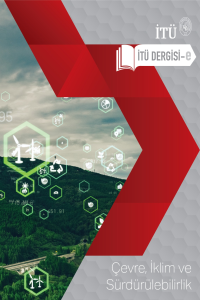Türk Endüstrisi için Temiz Üretim ve Yaşam Döngüsü Değerlendirmesi Örnekleri
yaşam döngüsü değerlendirmesi, temiz üretim, endüstri, atık azaltımı
___
- Azapagic, A. (1999). Life cycle assessment and its application to process selection, design and optimisation. Chemical Engineering Journal, 73(1), 1-21. https://doi.org/10.1016/s1385-8947(99)00042-x.
- Azapagic, A. (2010). Life cycle assessment as a tool for sustainable management of ecosystem services. In Ecosystem Services (Vol. 30, pp. 140-168). The Royal Society of Chemistry. http://dx.doi.org/10.1039/9781849731058-00140
- Baumann, H., & Tillman, A.-M. (2004). The Hitch Hiker's Guide to LCA: An Orientation in Life Cycle Assessment Methodology and Application. Studentlitteratur AB.
- Ecoinvent. (2013). Ecoinvent Database v3.1.
- Elginoz, N., M. Alzaboot, F. Germirli Babuna, G. Iskender (2019), “Construction of a large water treatment plant: appraisal of environmental hotspots”, Desalination and Water Treatment, Volume 172, pp 309–315, https://doi:10.5004/dwt.2019.25107
- EPA. (2006). Life Cycle Assessment: Principles and Practice (Washington, DC, Issue.
- Guinée, J. B., Gorrée, M., Heijungs, R., Huppes, G., Kleijn, R., Koning, A. d., Oers, L. v., Sleeswijk, A. W., Suh, S., Haes, H. A. U. d., Bruijn, H. d., Duin, R. v., Huijbregts, M. A. J., Lindeijer, E., Roorda, A. A. H., Ven, B. L. v. d., & Weidema, B. P. (2004). Handbook on Life Cycle Assessment: Operational Guide to the ISO Standards. Kluwer Academic Publishers.
- Guinee, J. B., Gorrèe, M., Heijungs, R., Huppes, G., Kleijn, G.R., van Oers, R.L., Wegener, L., Sleeswijk, A., Suh, S., de Haes, H.A. Udo, de Bruijn, H., van Duin, H.R., Huijbregts, M. A.J. (2001). Life Cycle Assessment, an Operational Guide to the ISO Standards. Part 2a: Guide. In. Kluwer Academic Publishers, Dordrecht
- ISO. (2006a). Life Cycle Assessment - Principles and Framework.
- ISO. (2006b). Life Cycle Assessment - Requirements and Guidelines.
- Karacal, P.N., N. Elginoz, F. Germirli Babuna (2019). “Environmental Burdens of Cataphoresis Process”, Desalination and Water Treatment, Volume 172, pp. 301–308, December, doi: https://doi.org/10.5004/dwt.2019.24800.
- Klöpffer, W., & Curran, M. A. (2014). How many case studies should we publish, if any? The International Journal of Life Cycle Assessment, 19(1), 1-2. https://doi.org/10.1007/s11367-013-0667-0.
- Örücü, E., ve Atilgan Türkmen, B. (2022). Evaluating the sustainability of car mat manufacturing. Sustainable Materials and Technologies, 32, e00402. https://doi.org/10.1016/j.susmat.2022.e00402
- Özkan, E., B. Bas, N. Elginoz, F. Germirli Babuna (2020), Environmental sensitivity of printed circuit board manufacturing to Cu recycling rate, transportation and various energy sources, International Journal of Global Warming, Vol. 20 No. 3, pp. 237 – 248, https://doi.org/10.1504/IJGW.2020.106596.
- Özkan, E., N. Elginoz, F. Germirli Babuna (2017). Life cycle assessment of a printed circuit board manufacturing plant in Turkey. Environmental Science and Pollution Research, https://doi.org/10.1007/s11356-017-0280-z.
- Özsahin, B., N. Elginoz, F. Germirli Babuna (2022). Life cycle assessment of a wind farm in Turkey. Environ Sci Pollut Res 29, 71000–71013. https://doi.org/10.1007/s11356-022-20783-0.
- Rebitzer, G., Ekvall, T., Frischknecht, R., Hunkeler, D., Norris, G., Rydberg, T., Schmidt, W. P., Suh, S., Weidema, B. P., & Pennington, D. W. (2004). Life cycle assessment: Part 1: Framework, goal and scope definition, inventory analysis, and applications. Environment International, 30(5), 701-720. https://doi.org/10.1016/j.envint.2003.11.005.
- Saad, A., N. Elginoz, F. Germirli Babuna, G. Iskender (2019), “Life cycle assessment of a large water treatment plant in Turkey”, Environmental Science and Pollution Research, May 2019, Volume 26, Issue 15, pp 14823–14834, https://doi.org/10.1007/s11356-018-3826-9.
- Sezginer, I., Atilgan Turkmen, B., & Germirli Babuna, F. (2022). Environmental impacts arising from the production of two surface coating formulations. Clean Technologies and Environmental Policy, 24(6), 1811-1822. https://doi.org/10.1007/s10098-022-02288-z.
- Sphera. (2017). GaBi V7.3 software and database.
- UNEP (2017a), Environmental agreements and cleaner production, Rapor, 21 sayfa, ISBN: 92-807-2717-6.
- UNEP (2017b) Cleaner Production Assessment in Dairy Processing, Prepared by COWI Consulting Engineers and Planners AS, Denmark, United Nations Environment Programme, Division of Technology, Industry and Economics and Danish Environmental Protection Agency, Rapor, 95 sayfa.
- Yalamacılar, B.B., N. Elginöz, F. Germirli Babuna (2021), “Benchmarking industrial water purification systems with the aid of life cycle assessment”, Desalination and Water Treatment, Vol.211, 422–431, http://dx.doi.org/10.5004/dwt.2021.26574.
- URL 1- https://www.temizuretimmerkezi.org/aktif-projelerimiz/ulusal-yasam-dongusu-degerlendirmesi-veri-tabaninin-gelistirilmesi-projesi_26
- Yayın Aralığı: Yılda 2 Sayı
- Başlangıç: 2022
- Yayıncı: İstanbul Teknik Üniversitesi
Türk Endüstrisi için Temiz Üretim ve Yaşam Döngüsü Değerlendirmesi Örnekleri
Fatoş GERMİRLİ BABUNA, Bilge BAŞ, Burçin ATILGAN TÜRKMEN, Nilay ELGİNÖZ KANAT
Ankara İli Atıksu Arıtma Tesisleri İşletme Problemleri ve İyileştirme Önerileri
Hakan SOYSAL, Muhammed ERCAN, Ahmet ALADAĞ, Çağrı SAMUR, Merve KIZILKAYA, Volkan YAVUZ, Erdem GÖRGÜN, Hakan ANLITAN, Onur KİRAZ, Burak Akın ARACI
Sürdürülebilir Yağmur Suyu Hasadı
Muhammed Nimet HAMİDİ, Nizamettin HAMİDİ, Onur IŞIK, Hüseyin GÜVEN, Hale ÖZGÜN, Mustafa Evren ERŞAHİN
Üniversitelerde Sürdürülebilirlik Çalışmaları: İstanbul Teknik Üniversitesi Örneği
Ebru ACUNER, Kadriye Elif MAÇİN, Feriha Kamile ÖZCAN, Arife Eymen KARABULUT, Börte KÖSE MUTLU, Lütfiye DURAK ATA
